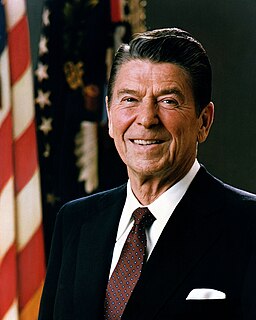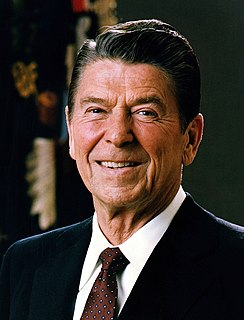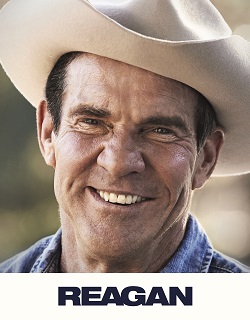Related Research Articles

George Herbert Walker Bush was an American politician, diplomat, and businessman who served as the 41st president of the United States from 1989 to 1993. A member of the Republican Party, he previously served as the 43rd vice president from 1981 to 1989 under Ronald Reagan, in the U.S. House of Representatives, as U.S. Ambassador to the United Nations, and as Director of Central Intelligence.

James Earl Carter Jr. is an American former politician who served as the 39th president of the United States from 1977 to 1981. A member of the Democratic Party, he previously served as the 76th governor of Georgia from 1971 to 1975 and as a Georgia state senator from 1963 to 1967. Since leaving office, Carter has remained engaged in political and social projects, receiving the Nobel Peace Prize in 2002 for his humanitarian work.

Nancy Davis Reagan was an American film actress and First Lady of the United States from 1981 to 1989. She was the second wife of president Ronald Reagan.

Ronald Wilson Reagan was an American politician who served as the 40th president of the United States from 1981 to 1989. A member of the Republican Party, he previously served as the 33rd governor of California from 1967 to 1975 after a career as a Hollywood actor and union leader.

Ronald Reagan's tenure as the 40th president of the United States began with his first inauguration on January 20, 1981, and ended on January 20, 1989. Reagan, a Republican from California, took office following a landslide victory over Democratic incumbent President Jimmy Carter in the 1980 presidential election. Four years later, in the 1984 election, he defeated Democrat former vice president Walter Mondale to win re-election in a larger landslide. Reagan was succeeded by his vice president, George H. W. Bush, who won the 1988 presidential election with Reagan's support. Reagan's 1980 election resulted from a dramatic conservative shift to the right in American politics, including a loss of confidence in liberal, New Deal, and Great Society programs and priorities that had dominated the national agenda since the 1930s.

In political studies, surveys have been conducted in order to construct historical rankings of the success of the presidents of the United States. Ranking systems are usually based on surveys of academic historians and political scientists or popular opinion. The scholarly rankings focus on presidential achievements, leadership qualities, failures and faults. Popular-opinion polls typically focus on recent or well-known presidents.

This is a timeline of the main events of the Cold War, a state of and military tension after World War II between powers in the Western Bloc and powers in the Eastern Bloc.

The Cold War period of 1985–1991 began with the rise of Mikhail Gorbachev as General Secretary of the Communist Party of the Soviet Union. Gorbachev was a revolutionary leader for the USSR, as he was the first to promote liberalization of the political landscape (Glasnost) and the economy (Perestroika); prior to this, the USSR had been strictly prohibiting liberal reform and maintained a command economy. The USSR, despite facing massive economic difficulties, was involved in a costly arms race with the United States under President Ronald Reagan. Regardless, the USSR began to crumble as liberal reforms proved difficult to handle and capitalist changes to the economy were badly instituted and caused major problems. The Cold War came to an end when the last war of Soviet occupation ended in Afghanistan, the Berlin Wall came down in Germany, a series of mostly peaceful revolutions swept the Soviet Bloc states of eastern Europe in 1989, and the Soviet Union collapsed and formally dissolved itself from existence in 1991.

Jack Foust Matlock Jr. is an American former ambassador, career Foreign Service Officer, a teacher, a historian, and a linguist. He was a specialist in Soviet affairs during some of the most tumultuous years of the Cold War, and served as the U.S. Ambassador to the Soviet Union from 1987 to 1991.

SAM 27000 was the second of two Boeing VC-137C United States Air Force aircraft that were specifically configured and maintained for the use of the president of the United States. It used the call sign Air Force One when the president was on board, and at other times it used the call sign SAM 27000, with SAM indicating 'Special Air Mission.' The VC-137C serial number 72-7000 was a customized version of the Boeing 707 which entered service during the Nixon administration in 1972. It served all US presidents until George W. Bush and was retired in 2001. It is now on display at the Ronald Reagan Presidential Library.

The 1980 presidential campaign of Ronald Reagan, was formally launched on November 13, 1979. Ronald Reagan and George H. W. Bush were elected president and vice president of the United States. They defeated the incumbent Democratic President Jimmy Carter and Vice President Walter Mondale. Reagan, a Republican and former governor of California, announced his third presidential bid in a nationally televised speech from New York City. He campaigned extensively for the primaries after losing the Iowa caucus to Bush. In the primaries, he won 44 states and 59.8% of the vote. He decided initially to nominate former president Gerald Ford as his running mate, but Ford wanted such extended powers as vice president that their ticket would effectively amount to a "co-presidency". As a result, negotiations to form a Reagan–Ford ticket ceased. Reagan then selected former Congressman and Director of the Central Intelligence Agency George H. W. Bush as his vice-presidential running mate.

George Pratt Shultz was an American economist, diplomat, and businessman. He served in various positions under three different Republican presidents and is one of only two people to have held four different Cabinet-level posts. Shultz played a major role in shaping the foreign policy of the Ronald Reagan administration. From 1974 to 1982, he was an executive of the Bechtel Group, an engineering and services company.
The presidency of Ronald Reagan began on January 20, 1981, when Ronald Reagan was inaugurated as the 40th president of the United States, and ended on January 20, 1989.

In 1981, following his defeat in the 1980 United States presidential election, former U.S. president Jimmy Carter returned to Georgia to his peanut farm, which he had placed into a blind trust during his presidency to avoid even the appearance of a conflict of interest. He found that the trustees had mismanaged the trust, leaving him more than one million dollars in debt. In the years that followed, he has led an active life, establishing the Carter Center, building his presidential library, teaching at Emory University in Atlanta, and writing numerous books. He has also contributed to the expansion of Habitat for Humanity, to build affordable housing. Since early September 2012, Carter has been alive longer after leaving the White House than any other U.S. president, currently at 41 years, 150 days.

Reagan is an upcoming biographical historical drama film directed by Sean McNamara, starring Dennis Quaid and David Henrie as United States President Ronald Reagan. The film also features Penelope Ann Miller, Kevin Dillon, Nick Searcy, Skip Schwink, Mena Suvari, Lesley-Anne Down and Jon Voight in supporting roles. The movie is based on the books: The Crusader: Ronald Reagan and the Fall of Communism and God and Ronald Reagan: A Spiritual Life by Paul Kengor.
References
| Previous | Lists of covers of Time magazine | Next |
|---|---|---|
| 1970s | 1980s | 1990s |